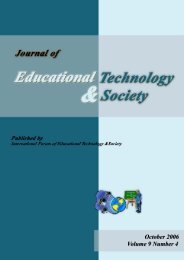Student Engagement: What do we know and what should we do?
Student Engagement: What do we know and what should we do?
Student Engagement: What do we know and what should we do?
You also want an ePaper? Increase the reach of your titles
YUMPU automatically turns print PDFs into web optimized ePapers that Google loves.
• <strong>Student</strong>s want their teachers to <strong>know</strong> how they learn. They want their<br />
teachers to take into account <strong>what</strong> they underst<strong>and</strong> <strong>and</strong> <strong>what</strong> they<br />
misunderst<strong>and</strong>, <strong>and</strong> to use this <strong>know</strong>ledge as a starting place to guide<br />
their continued learning.<br />
• <strong>Student</strong>s want their teachers to establish learning environments that<br />
build interdependent relationships <strong>and</strong> that promote <strong>and</strong> create a strong<br />
culture of learning (p. 36).<br />
Today’s learners seem to need to connect <strong>and</strong> communicate constantly <strong>and</strong> want their<br />
environment to support that preference. Educators from “older” generations might see<br />
technical forms of communication such as computer chatting or texting “as the opposite<br />
<strong>and</strong> the antithesis of contact, for the Net Gen it is certainly not seen as such…it allows<br />
interaction with a variety of people <strong>and</strong> material” (Windham, 2005, p. 5.7). As reported<br />
earlier, Dunleavy & Milton (2009) asked students <strong>what</strong> their ideal school would look like<br />
<strong>and</strong> <strong>what</strong> type of learning environment increases engagement. <strong>Student</strong>s listed three<br />
criteria that correlate to the concept of interaction: (1) Learn from <strong>and</strong> with each other<br />
<strong>and</strong> people in their community, (2) Connect with experts <strong>and</strong> expertise, <strong>and</strong> (3) Have<br />
more opportunities for dialogue <strong>and</strong> conversation (p. 10).<br />
These dialogues <strong>and</strong> conversations extend beyond the classroom. When learners have<br />
problems engaging in Physics, they want to talk to engineers in the field. Windham<br />
(2005) suggests, “students <strong>should</strong> be given the opportunity to interact with faculty <strong>and</strong><br />
researchers outside the confines of the curriculum <strong>and</strong> to develop meaningful<br />
relationships with them (p. 5.8). Facilitating such exp<strong>and</strong>ed relationships requires a shift<br />
from vertical to horizontal classrooms – no longer the sage on the stage, teachers are<br />
learning along side students, helping them actively construct their learning experiences<br />
<strong>and</strong> <strong>know</strong>ledge. As Friesen notes in Dunleavy & Milton (2009),<br />
Authentic intellectual engagement requires a deeper reciprocity in the teachinglearning<br />
relationship where students’ engagement begins as they actively<br />
construct their learning in partnership with teachers, work toward deep conceptual<br />
underst<strong>and</strong>ing, <strong>and</strong> contribute their own ideas to building new <strong>know</strong>ledge or<br />
devising new practices in activities that are “worthy of their time <strong>and</strong> attention<br />
(Friesen, 2008, p. 8, as cited in Dunleavy & Milton, 2009, p. 14).<br />
This model contains more interaction, negotiation, <strong>and</strong> exploration among learners <strong>and</strong><br />
teachers, as they explore <strong>and</strong> discuss the content together, often with the teachers<br />
modeling learning as opposed to telling students <strong>what</strong> the ans<strong>we</strong>rs, process, or outcomes<br />
<strong>should</strong> be (Claxton, 2007). Open, caring, respectful relationships bet<strong>we</strong>en learners <strong>and</strong><br />
their teachers is essential to develop <strong>and</strong> support social <strong>and</strong> psychological engagement in<br />
learning, but also becomes part of the new curriculum itself, as described by Dunleavy &<br />
Milton (2009).<br />
Effective learning experiences are also shaped by student-teacher relationships<br />
that support the development of young peoples’ social <strong>and</strong> emotional<br />
competencies. As students progress through middle <strong>and</strong> secondary schools, they<br />
face increasing complexity. <strong>Student</strong>s themselves consistently say that <strong>what</strong> most<br />
<strong>Student</strong> <strong>Engagement</strong>: <strong>What</strong> <strong>do</strong> <strong>we</strong> <strong>know</strong> <strong>and</strong> <strong>what</strong> <strong>should</strong> <strong>we</strong> <strong>do</strong>? 37












